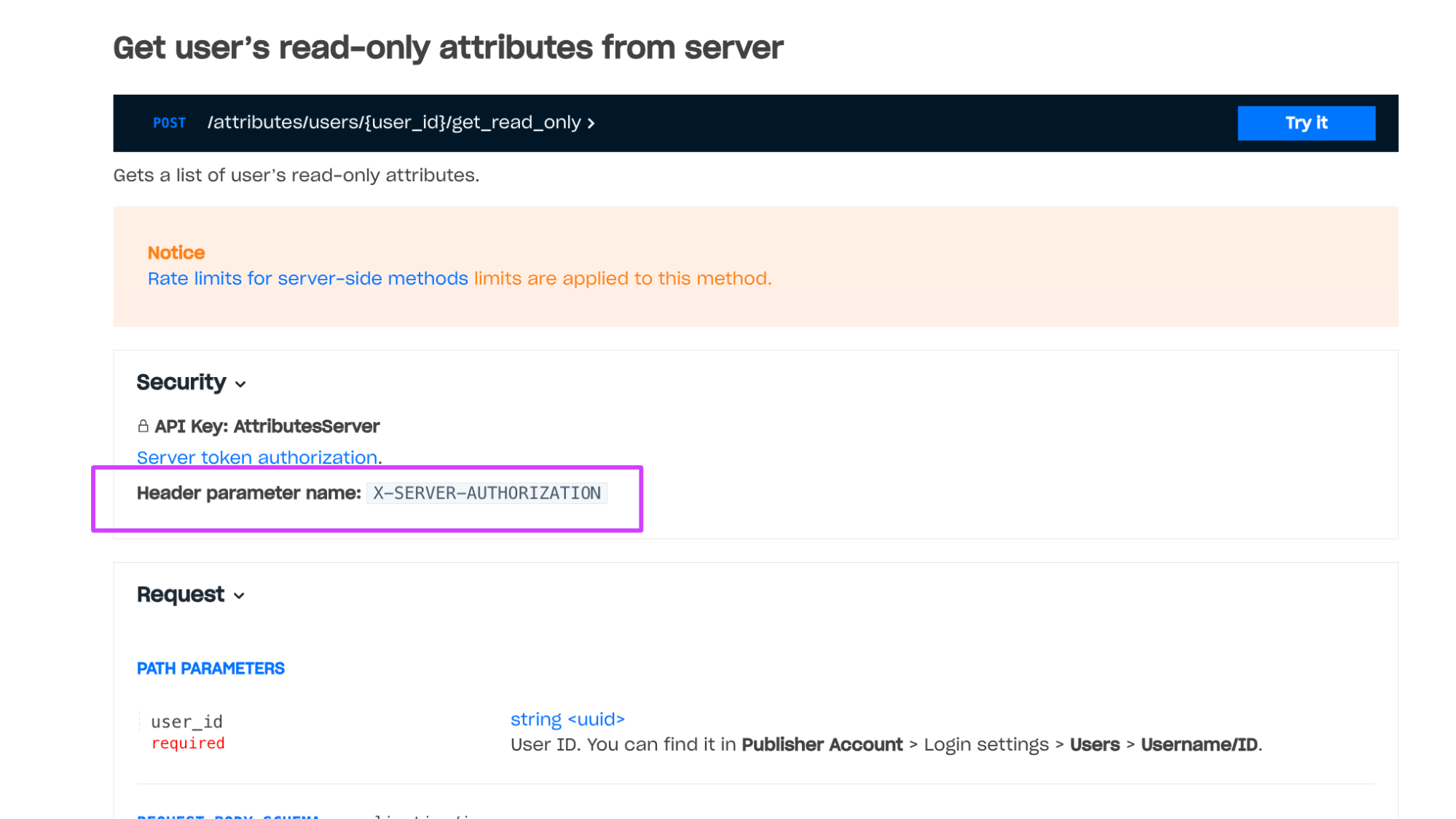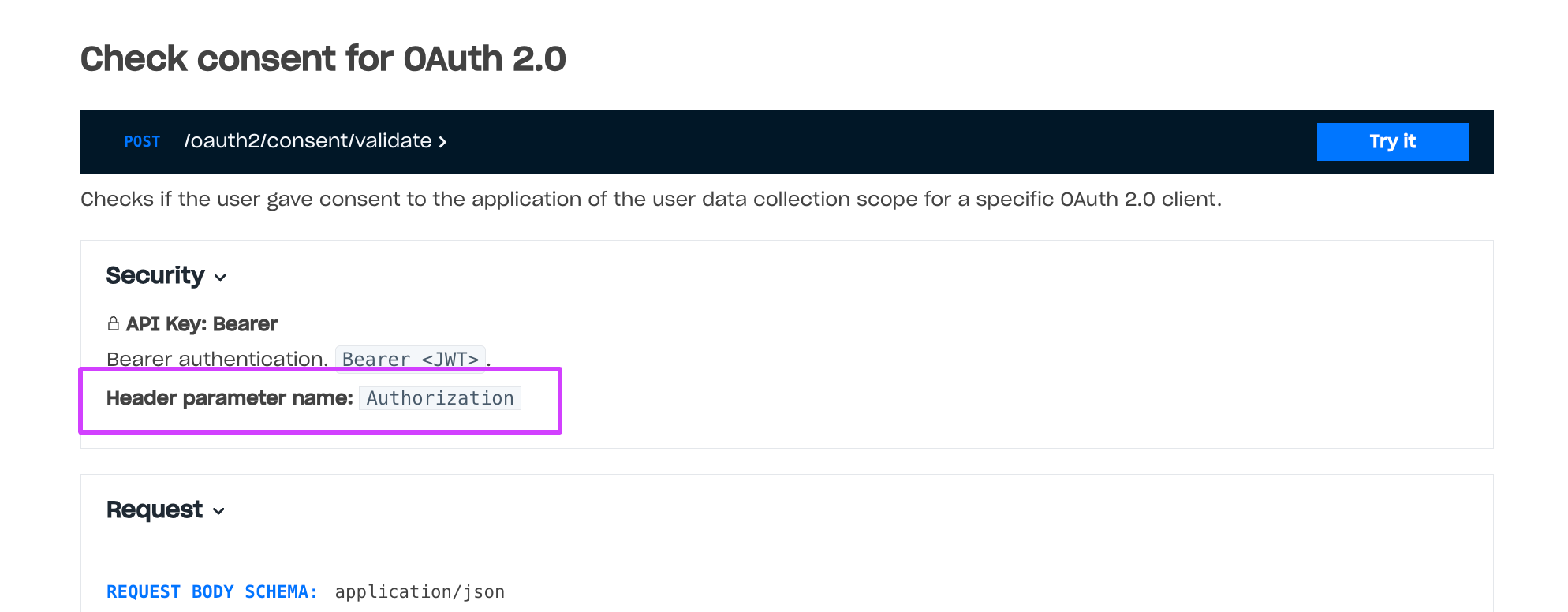- Versão: 1.0.0
- Servidores:
https://login.xsolla.com/api - Protocolos: https
- Aceita: application/json
- Responde com: application/json
- Entre em contato conosco por e-mail
- URL de contato: https://xsolla.com/
Esta seção descreve as chamadas de API para trabalhar com Login. Configure seu projeto Login na Conta de Distribuidor antes de enviar solicitações.
Você tem acesso aos seguintes tipos de projeto Login na Conta de Distribuidor:
- Projeto Login padrão
- Projeto Shadow Login
Para obter mais informações sobre ele, consulte o recurso Conta multiplataforma.
A Login API oferece suporte aos seguintes tipos de token:
- Token de usuário. Ele é usado para enviar solicitações para os seguintes
recursos do usuário:
- perfil
- amigos
- atributos
- Token de servidor. Ele é usado para enviar solicitações para recursos do aplicativo, como configurações ou dados do usuário. As seguintes solicitações estão disponíveis:
Você pode determinar se uma chamada de API ocorre no lado do cliente ou do servidor pelo esquema de autenticação:
- Client-side — are called without authentication or with the
Authorizationheader:Bearer <user_JWT>header, where<user_JWT>— is the user token. - Server-side API calls for implementing the user flow — are called with the
header:
X-SERVER-AUTHORIZATION: <server_JWT>, where<server_JWT>— is the server token.
Para obter o token, envie uma das seguintes solicitações:
- registro de usuário (JWT ou OAuth 2.0)
- autenticação por nome de usuário e senha (autenticação JWT, OAuth 2.0 ou JWT por nome de usuário e senha)
- autenticação via redes sociais (JWT ou OAuth 2.0)
- autenticação silenciosa (JWT ou OAuth 2.0)
- Autenticação por meio de um token de acesso à rede social
- autenticação através de uma plataforma de publicação
Após a autenticação JWT, o usuário é redirecionado para o URL de retorno de
chamada com um token em um parâmetro de consulta: <Callback URL>?token=<User token (JWT)>.
After OAuth 2.0 protocol-based authentication, send the Generate
JWT POST
request to the Xsolla Login server to exchange the received code parameter
for a user token (access_token).
When the access token expires, the client sends Generate
JWT POST
request endpoint on the Xsolla Login server. The request body must include the
following parameters:
grant_type— JWT grant type, pass therefresh_tokenvalue.client_id— OAuth 2.0 client ID.refresh_token— refresh token received in response to the user authorization request.
Para obter um token de servidor:
Configure o cliente OAuth 2.0 do servidor
- Abra seu projeto na Conta de Distribuidor e vá para a seção Login.
- Clique em Configure no painel de um projeto Login.
- Vá para o bloco Security e selecione a seção OAuth 2.0.
- Clique em Adicionar cliente OAuth 2.0.
- Marque a caixa Server (server-to-server connection).
- Especifique o Tempo de vida do token.
- Clique em Connect.
- Copie e salve o ID do cliente e a chave secreta.
Geração do JWT do servidor
No back-end do seu aplicativo, implemente um método para obter o JWT do servidor usando a chamada Generate JWT API. A solicitação deve conter os seguintes parâmetros:
grant_typeé o tipo de obtenção de JWT; passa o valorclient_credentials.client_secreté a chave secreta que é recebida quando você configura o cliente OAuth 2.0 do servidor.client_idé o ID do cliente recebido quando você configura o cliente OAuth 2.0 do servidor.
When the server token expires, generate a new token using the Generate JWT API call. The request body must include the following parameters:
grant_type— JWT grant type, pass theclient_credentialsvalue.client_id— OAuth 2.0 client ID.client_secret— OAuth 2.0 client secret key.
Para evitar sobrecarregar o sistema Xsolla e proteger contra picos repentinos
no tráfego de entrada, a Xsolla limita o número de solicitações recebidas pela
API Xsolla dentro de um período de tempo especificado. Se o limite for
excedido, a API Xsolla retornará uma resposta HTTP com o código de status
429.
Rate limits vary by method, IP-address, authentication scheme, and other factors.
Rate limits for server-side methods are applied to methods with server-side
authentication — methods that are called with the X-SERVER-AUTHORIZATION:
<server_JWT> header, where <server_JWT> is the server
token.
Rate limits for client-side methods are applied to methods without
authentication or with client-side authentication — methods that are called
with the Authorization: Bearer <user_JWT> header, where
<user_JWT> is the user token.
Example of a method with server-side authentication:  Example of a method with client-side authentication:
Example of a method with client-side authentication:

Os limites de taxa para métodos do lado do cliente não mudam e são necessários para evitar ataques de força bruta. A taxa máxima de solicitação para métodos do lado do servidor é maior do que para métodos do lado do cliente. Você pode consultar as recomendações sobre como gerenciar limites de taxa na documentação.
Cada token tem um formato JWT e contém uma informação definida em uma carga.
O JWT do usuário é um token recebido como resultado da autenticação ou cadastro. Uma carga de token contém informações sobre o usuário e a chamada de autenticação.
Para obter um token de usuário por meio do protocolo OAuth 2.0, você precisa de
um cliente OAuth 2.0. O token de usuário é passado no cabeçalho Authorization: Bearer <JWT>.
Um token conterá as principais declarações após a autenticação ou confirmação do endereço de e-mail. A presença dessas declarações não depende do banco de dados do usuário e da chamada de autenticação.
| Reivindicar | Tipo | Obrigatório | Descrição |
exp |
Carimbo de data/hora Unix | Sim | Data e hora da expiração do token. O tempo de expiração padrão é de 24 horas. Você pode alterar o tempo de expiração para cada projeto Login. |
iss |
cadeia de caracteres | Sim | Serviço que assinou o token: https://login.xsolla.com. |
iat |
Carimbo de data/hora Unix | Sim | Data e hora de entrega do token. |
sub |
cadeia de caracteres (UUID) | Sim | ID do usuário escrito no lado do servidor Xsolla Login. |
groups |
matriz | Sim |
A lista de grupos em que o usuário está. Cada grupo é escrito no seguinte formato:
Só pode haver um grupo padrão. Esse grupo inicialmente inclui todos os usuários antes que eles sejam distribuídos em grupos diferentes. |
xsolla_login_project_id |
cadeia de caracteres (UUID) | Sim | ID do projeto Login. |
type |
cadeia de caracteres |
Opção de autenticação:
Só pode haver um grupo padrão. Esse grupo inicialmente inclui todos os usuários antes que eles sejam distribuídos em grupos diferentes. |
|
avatar |
cadeia de caracteres | URL do avatar do usuário. | |
username |
cadeia de caracteres | Nome de usuário. | |
publisher_id |
número inteiro | ID de um comerciante que possui um projeto de login. | |
email |
cadeia de caracteres | Endereço de e-mail do usuário. | |
payload |
cadeia de caracteres | Informações adicionais que são passadas no parâmetro de carga durante a autenticação. | |
promo_email_agreement |
valor booleano |
Pode ter um dos seguintes valores:
true por padrão.
Para adicionar o recurso ao formulário de registro do Login widget:
|
|
connection_information |
cadeia de caracteres | Mostra se o usuário confirmou a data de nascimento ou não. A confirmação é feita através do serviço okname. |
Declarações contidas no token após a autenticação se você usar o armazenamento PlayFab.
| Reivindicar | Tipo | Obrigatório | Descrição |
external_account_id |
cadeia de caracteres | Sim | ID do usuário PlayFab. |
session_ticket |
cadeia de caracteres | Sim |
Um parâmetro SessionTicket recebido durante uma solicitação de autenticação ou solicitações para a PlayFab API. Um token conterá a declaração se você autenticar usuários por meio do protocolo OAuth 2.0 e passar o valor |
entity_token |
cadeia de caracteres | Sim | Um parâmetro EntityToken.EntityToken. |
entity_type |
cadeia de caracteres | Sim | Um parâmetro EntityToken.Entity.Type. Só aceita o valor title_player_account. |
entity_id |
cadeia de caracteres | Sim | Um parâmetro EntityToken.Entity.Id. |
Declarações contidas no token após a autenticação se você usar armazenamento personalizado.
| Reivindicar | Tipo | Obrigatório | Descrição |
provider |
cadeia de caracteres | Sim | Nome de uma rede social usada para autenticação. Se o usuário autenticar via nome de usuário e senha, a declaração terá o valor xsolla. |
external_account_id |
cadeia de caracteres | ID do usuário no lado do servidor. | |
partner_data |
Data of any type returned by your server in the response body during authentication. To enable the transmission of this claim, contact your Customer Success Manager or email to csm@xsolla.com | ||
social_access_token |
Access token of the social network through which the user was authenticated. To enable the transmission of this claim, contact your Customer Success Manager or email to csm@xsolla.com. |
Reivindicação que está contida no token após a autenticação por meio de um número de telefone.
| Reivindicar | Tipo | Obrigatório | Descrição |
phone_number |
cadeia de caracteres | Sim | Número de telefone do usuário usado para autenticação. O formato de número de telefone com base no código do país, código de área e número de linha sem divisórias. |
O token do servidor é passado no cabeçalho X-SERVER-AUTHORIZATION.
A carga do token contém informações sobre recursos pertencentes ao cliente OAuth 2.0. O token tem acesso a chamadas com autenticação baseada em servidor para esses recursos.
| Reivindicar | Tipo | Obrigatório | Descrição |
xsolla_login_project_id |
cadeia de caracteres (UUID) | Sim | ID de um projeto Login que possui o cliente OAuth 2.0. |
resources |
matriz | Sim |
Lista de recursos pertencentes a um cliente OAuth 2.0. Tipos possíveis de recursos:
Cada grupo é escrito no seguinte formato:
|
jti |
cadeia de caracteres | Sim | ID de token exclusivo. |
To validate the JWT, use the following Login API calls:
- User JWT validate — for a user token.
- Server JWT validate — for a server token.
Aviso
Não revele sua chave secreta a ninguém. Se ela foi comprometida, atualize-a.
Refer to the documentation for information about Xsolla Login API errors.